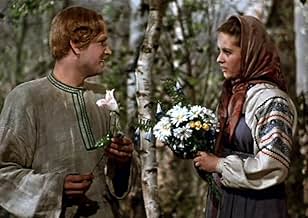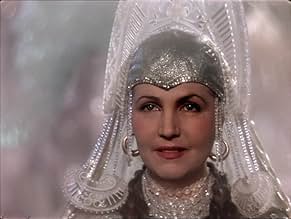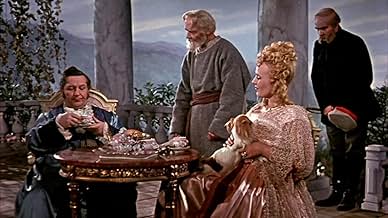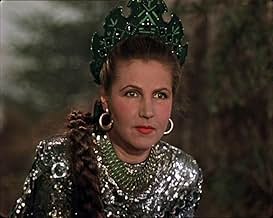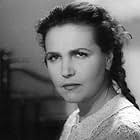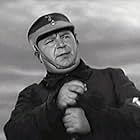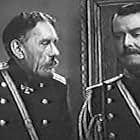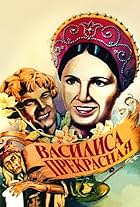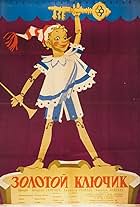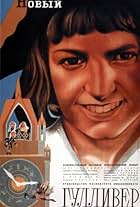Obsessed with perfecting his craft, young gemcutter Danilo visits the mystical Copper Mountain to uncover the secret behind its infamous attraction - the Stone Flower, a stone carving so cap... Read allObsessed with perfecting his craft, young gemcutter Danilo visits the mystical Copper Mountain to uncover the secret behind its infamous attraction - the Stone Flower, a stone carving so captivating that no one can leave after seeing it.Obsessed with perfecting his craft, young gemcutter Danilo visits the mystical Copper Mountain to uncover the secret behind its infamous attraction - the Stone Flower, a stone carving so captivating that no one can leave after seeing it.
- Director
- Writers
- Stars
- Awards
- 2 wins & 2 nominations total
Vladimir Druzhnikov
- Danilo - master
- (as V. Druzhnikov)
Yekaterina Derevshchikova
- Katya
- (as Y. Derevshchikova)
Mikhail Troyanovskiy
- Prokopych
- (as M. Troyanovsky)
Mikhail Yanshin
- Severyan
- (as M. Yanshin)
Nikolay Temyakov
- Barin
- (as N. Temyakov)
Anna Petukhova
- Barina
- (as A. Petukhova)
Nikolai Orlov
- Stary master
- (as N. Orlov)
Lidiya Deikun
- Vikhorika
- (as L. Deikun)
Serafim Zaytsev
- Yefimka
- (as S. Zaytsev)
Vitaliy Kravchenko
- Danilo - malchyk
- (as V. Kravchenko)
- Director
- Writers
- All cast & crew
- Production, box office & more at IMDbPro
Featured reviews
For the commentator below, I thought I had seen it on tape but I'm not sure. Most probably saw it an art house in Chicago or some university festival (Roosevelt University had a very good one back then).
The film's use of color was a landmark breakthrough. It was a process different and superior to technicolor. We can do it today in say, Kodacolor, and "The Red Shoes" did indeed quite approximate it but good as that was, it did not equal SF,
I wonder if Martin Scorcese, who did a commentary for "The Red Shoe" saw it. I'm sure he would have been impressed and if someone could get to him today he might even promote putting it on DVD just for gras artis gras.
The film was of some importance politically too in that it was the first kind of cultural exchange gesture the Soviets made at the height of the cold war. We probably sent them "Gone With The Wind." I mean that.
The film's use of color was a landmark breakthrough. It was a process different and superior to technicolor. We can do it today in say, Kodacolor, and "The Red Shoes" did indeed quite approximate it but good as that was, it did not equal SF,
I wonder if Martin Scorcese, who did a commentary for "The Red Shoe" saw it. I'm sure he would have been impressed and if someone could get to him today he might even promote putting it on DVD just for gras artis gras.
The film was of some importance politically too in that it was the first kind of cultural exchange gesture the Soviets made at the height of the cold war. We probably sent them "Gone With The Wind." I mean that.
An old man recounts a fairy-tale to a group of children about a stone-cutter, "Danila", who strives for perfection and meets with the mystical "Queen of Copper Hill". She asks him to sacrifice himself and remain with her in her unreachable world of stone at the expense of his married life with "Katinka", the girl he loves and whom he has just married.
The film is made in colour which is refreshing for 1946 and it is 15 minutes longer than described on IMDb. However, the story drags. The Russian hierarchy is very effectively captured - we witness the cruelties of the ruling classes who take to flogging the poor. They don't just flog them, they beat them to death for not working hard enough or not finishing a piece of work in time. Danila's talent at stone sculpture results in him being commissioned to make a piece for a wealthy landowner who wants to show off. However, the "Queen of Copper Hill" intervenes. It takes ages for this part of the story to get going, though.
Vladimir Druzhnikov is good in the lead role as "Danila". He looks a bit gay and girlie and very much suits the artistic type that is required for the film. The sets within the world of stone in Copper Hill are interesting in a "Star Trek" kind of way but each section of the film just seems to drag on for too long. Apart from the dance sequence in the wedding episode - one of the more entertaining parts of the film.
I also felt that the ending of the film could have been better. It's a happy-ending story but it would have been far more effective as a tragedy. We are led to believe that the Queen of Copper Hill has an evil sacrifice up her sleeve and that someone is going to get turned to stone for eternity. This is exactly what the film needs. But it doesn't happen. She suddenly switches to a goodie and we get a "love conquers all" message which is a disappointment. The film keeps you watching with false expectations and I felt cheated at the end. The rules suddenly change from "You can never go back!" to "Ok you can go back now". Very lame. The film needed an effective finale, ie, some tragedy, to redeem the rest of the tedious film but it didn't happen. It scores for novelty value only.
The film is made in colour which is refreshing for 1946 and it is 15 minutes longer than described on IMDb. However, the story drags. The Russian hierarchy is very effectively captured - we witness the cruelties of the ruling classes who take to flogging the poor. They don't just flog them, they beat them to death for not working hard enough or not finishing a piece of work in time. Danila's talent at stone sculpture results in him being commissioned to make a piece for a wealthy landowner who wants to show off. However, the "Queen of Copper Hill" intervenes. It takes ages for this part of the story to get going, though.
Vladimir Druzhnikov is good in the lead role as "Danila". He looks a bit gay and girlie and very much suits the artistic type that is required for the film. The sets within the world of stone in Copper Hill are interesting in a "Star Trek" kind of way but each section of the film just seems to drag on for too long. Apart from the dance sequence in the wedding episode - one of the more entertaining parts of the film.
I also felt that the ending of the film could have been better. It's a happy-ending story but it would have been far more effective as a tragedy. We are led to believe that the Queen of Copper Hill has an evil sacrifice up her sleeve and that someone is going to get turned to stone for eternity. This is exactly what the film needs. But it doesn't happen. She suddenly switches to a goodie and we get a "love conquers all" message which is a disappointment. The film keeps you watching with false expectations and I felt cheated at the end. The rules suddenly change from "You can never go back!" to "Ok you can go back now". Very lame. The film needed an effective finale, ie, some tragedy, to redeem the rest of the tedious film but it didn't happen. It scores for novelty value only.
10holcombe
I saw "The Stone Flower" in 1952 at Iowa State University's (then a state college) student union. I was a second or third grader, but I have never forgotten the magic of this Russian fable, the movie's gorgeous images and its powerful drama. I remember a wicked queen who turned the heroine into stone and the soft images of the lush rose-colored stone flower that remained for the hero to find after great struggles with the evil queen and her sinister minions.
Some sets were simple and rather bare. I like the earlier comment about "The Red Shoes," another post-war film from the recovering European film industries, with the same pre-war quality story lines and great effort to use color and images well, but with truly scarce resources.
I am so thrilled to find that others remember this wonderful film that seemed to have disappeared. I hope someone can find a print to share with film historians and certainly with other children. More than 50 years later, I can thank my mother for taking me to share the beautiful Stone Flower that I have never forgotten.
Some sets were simple and rather bare. I like the earlier comment about "The Red Shoes," another post-war film from the recovering European film industries, with the same pre-war quality story lines and great effort to use color and images well, but with truly scarce resources.
I am so thrilled to find that others remember this wonderful film that seemed to have disappeared. I hope someone can find a print to share with film historians and certainly with other children. More than 50 years later, I can thank my mother for taking me to share the beautiful Stone Flower that I have never forgotten.
This faux (?) folktale, probably the best known film of Soviet fabulist Aleksandr Ptushko, is a paean to artistic individuality: a daydreaming youth becomes protégé to an old stone carver; visits the secret cave of a mountain witch to delve into his art; and then, with the unwavering trust of his deserted bride, finds his way back into the world as absolute master of his craft. A rather non-collective idea to find in the Stalinist film world of the time. Ptushko's style often looks like some over-decorated/Russian-themed Christmas window, but it certainly fits his subject. The crudity in the technique comes off as sincerity and the USSR color processing of the era is often quite lovely if you boost the brightness level on your equipment. Aimed at kids, but probably best for grown up cultural Sovietologists.
NOTE: Check out the DVD extras for an amazing stop-motion animation clip from Ptsuhko's 1936 pic THE NEW GULLIVER.
NOTE: Check out the DVD extras for an amazing stop-motion animation clip from Ptsuhko's 1936 pic THE NEW GULLIVER.
The Stone Flower as a piece of cinematic art, seems to surpass Disney, or The Wizard of Oz, in a similar visual vein, and always clearly presents it's own unique impeccable, and intricate attention to delicate detail, not found in many other films.
There is a pleasing sense of welcoming and invitingness to the film, and with kindness and gladness it opens itself up to you to come along and enjoy.
Great care, classiness, and refinement abound in the production of The Stone Flower, and it makes for a beautiful experience to watch. And whether you can understand Russian, or not, visually the story will keep it's pace, and lead the way for you quite clearly.
The Stone Flower is a tale of folk, and a tale of beautifulness and happiness, and it is sprinkled in the icing sugar of magicalness, and fantasy!
A very lovely film! :)
There is a pleasing sense of welcoming and invitingness to the film, and with kindness and gladness it opens itself up to you to come along and enjoy.
Great care, classiness, and refinement abound in the production of The Stone Flower, and it makes for a beautiful experience to watch. And whether you can understand Russian, or not, visually the story will keep it's pace, and lead the way for you quite clearly.
The Stone Flower is a tale of folk, and a tale of beautifulness and happiness, and it is sprinkled in the icing sugar of magicalness, and fantasy!
A very lovely film! :)
Did you know
- ConnectionsFeatured in Good Bye, Sowjetunion! (2021)
Details
- Runtime1 hour 29 minutes
- Sound mix
- Aspect ratio
- 1.37 : 1
Contribute to this page
Suggest an edit or add missing content



